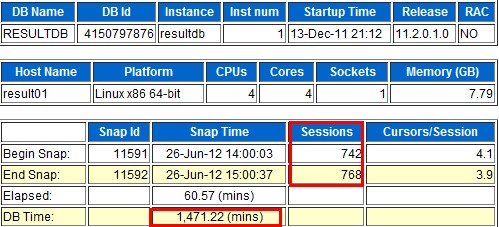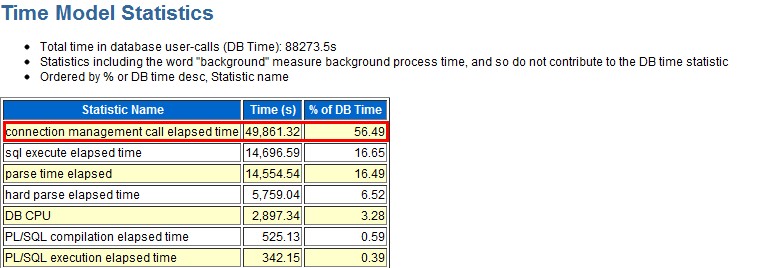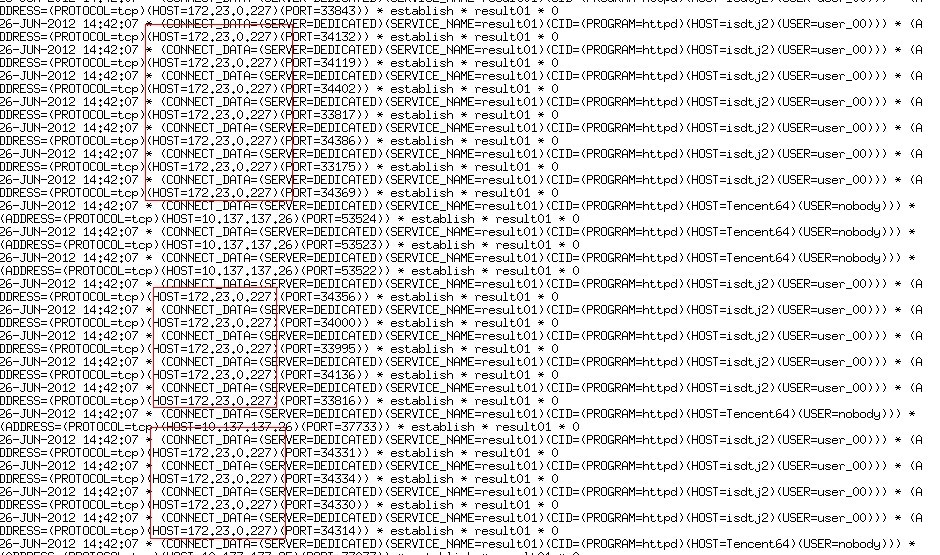今天查找TX Enqueue看到的一篇文章,拿出来共享下
PURPOSE
-------------
To find the TX Enqueue contention in a RAC or OPS environment
What is TX Enqueue ?
In one word oracle is maintaining queue for transaction.
How Many Resources ?
1/ active transaction
How Many Locks?
1/transaction + 1/process waiting for a locked row by that
transaction.
How Many Users?
1 + 1/ process waiting for something locked by this transaction.
Who Uses?
All processes
What need to investigate?
The mode of TX (6/4), Holding/Waiting/Requesting
SCOPE & APPLICATION
=====================
This document will help to analyze the application design related to transaction bottlenecks
and database performance tuning.
Let start with an example:
===================
create table akdas (A1 number, Col1 Varchar2(10), Col2 Varchar2(10));
insert into akdas values(5,'Hello','Hi');
insert into akdas values(6,'Sudip','Datta');
insert into akdas values(7,'Preetam','Roy');
insert into akdas values(8,'Michael','Polaski');
From Node 1:
==========
update akdas set a1=11 where a1=6;
From Node 2:
==========
update akdas set a1=12 where a1=7;
update akdas set a1=11 where a1=6; /* this will wait for Node1: to complete the transaction */
This Note Is Made To Analyzing Only the TX-Mode-6 (Exclusive).
1. Now run the following query to track down the problem: Who is waiting
===================================================================
prompt
prompt Query 1. Waiting for TX Enqueue where mode is Exclusive
prompt =====================================
prompt
set linesize 100
set pagesize 66
col c1 for a15
col c1 heading "Program Name "
select l.inst_id,l.SID,program c1,l.TYPE,l.ID1,l.ID2,l.LMODE,l.REQUEST
from gv$lock l,gv$session s
where l.type like 'TX' and l.REQUEST =6
and l.inst_id=s.inst_id and l.sid=s.sid
order by id1
/
Output will be here
===============
INST_ID SID Program Name TY ID1 ID2 LMODE REQUEST
----------- ---------- ------------------ --- -------- -------- ---------- --------
2 13 sqlplus@opcbsol TX 393236 780 0 6
2 (TNS V1-V3)
It is clear that SID 12 of instance 2 is doing a DML and waiting on REQUEST Mode 6.
2. Let's run the next query to find who is holding
===========================================
prompt
prompt
prompt Query 2. Holding for TX Enqueue where mode greater than 6
prompt =======================================
prompt
set linesize 100
set pagesize 66
col c1 for a15
col c1 heading "Program Name "
select l.inst_id,l.SID,program c1,l.TYPE,l.ID1,l.ID2,l.LMODE,l.REQUEST
from gv$lock l,gv$session s
where l.type like 'TX' and l.LMODE =6 and (l.ID1,l.ID2) in
(select id1,id2 from gv$lock where type like 'TX' and REQUEST =6)
and l.inst_id=s.inst_id and l.sid=s.sid
order by id1
/
Output will be here
===============
INST_ID SID Program Name TY ID1 ID2 LMODE REQUEST
---------- ---------- -------------- --- ---------- -------- ----------- --------
1 12 sqlplus@opcbsol TX 393236 780 6 0
1 (TNS V1-V3)
So holder is SID 12 on instance 1. Where LMODE = 6.
3. Let's find out the exact file#, block# and Record# where it is waiting
===============================================================
prompt
prompt
prompt Query 3. Object# ,File#, Block# and Slot# TX Enqueue in detail
prompt ========================================
prompt
set linesize 110
col c0 for 999
col c0 heading "INS"
col c1 for a15
col c1 heading "Program Name "
select inst_id c0,sid,program c1,ROW_WAIT_OBJ# object_no, ROW_WAIT_FILE# Rfile_no,
ROW_WAIT_BLOCK# Block_no ,ROW_WAIT_ROW# Row_no
from gv$session
where (inst_id,sid) in (select inst_id,sid from gv$session_wait where p1='1415053318')
/
Output Will be here
===============
INS SID Program Name OBJECT_NO RFILE_NO BLOCK_NO ROW_NO
----- ---------- ------------- --------------- --------- -------
2 13 sqlplus@opcbsol 7261 9 12346 1
2 (TNS V1-V3)
From the output, it is clear that it is waiting on Relative_File# 9, Block# 12346, Row Number 1.
Here Row Number 1 means the slot number in the block 12346. This Row_No start from 0 (zero).
4. Let's Find the object details
=============================
prompt
prompt
prompt Query 4. Object Involve for TX Enqueue in detail
prompt ===============================
prompt
set linesize 100
set pagesize 100
col owner for a10
col object_name for a20
col object_type for a10
select owner,object_name,object_id,object_type
from dba_objects
where
object_id in (select ROW_WAIT_OBJ# from gv$session
where (inst_id, sid) in (select inst_id,sid from gv$session_wait where p1='1415053318'))
/
Output Will be here
===============
OWNER OBJECT_NAME OBJECT_ID OBJECT_TYP
--------- ------------ -------- -----------
AKDAS AKDAS 7261 TABLE
5. Let’s find the row value details
=============================
prompt
prompt
prompt Query 5. Finding the row value
prompt ====================
prompt
select * from <Owner>.<Table Name> where rowid like
DBMS_ROWID.ROWID_CREATE(1,&Object_No,&Rfile_No, &Block_No, &Row_Number)
/
From query 3 and 4 we will get the value for all variables.
Owner = AKDAS
Table_Name = AKDAS
Object_No = 7261
Rfile_No = 9
Block_No = 12346
Row_Number = 1
Output Will be here
===============
A1 Col1 Col2
---------- --------------- ----------
6 Hello Hi
So we can drag down to the row value where TX Enqueue contention exists.
6. Let’s find the user activity that is "Holder" and "Waiter"
====================================================
set linesize 120
set pagesize 66
col c0 for 999
col c0 heading "INS"
col c1 for a9
col c1 heading "OS User"
col c2 for a9
col c2 heading "Oracle User"
col c3 for a15
col c3 heading "Program Name"
col b1 for a9
col b1 heading "Unix PID"
col b2 for 9999 justify left
col b2 heading "ORA SID"
col b3 for 999999 justify left
col b3 heading "SERIAL#"
col sql_text for a45
set space 1
break on b1 nodup on c0 nodup on c3 nodup on c1 nodup on c2 nodup on b2 nodup on b3 skip 2
select a.inst_id c0,b.sid b2,c.spid b1, b.program c3, b.username c2,b.serial# b3, a.sql_text
from gv$sql a, gv$session b, gv$process c
where
a.address = b.sql_address
and b.paddr = c.addr
and a.hash_value = b.sql_hash_value
and a.inst_id=b.inst_id and a.inst_id=c.inst_id
and a.inst_id like '&inst_id' and b.sid like '&sid'
order by c.spid,a.hash_value
/
This query asks the Instance Number and Sid number, which you can get from step 1 and 2.
But remember , you can see the waiter activity, but you may not see the holder activity.
Reason is, the holder is sitting idle after doing the DML operation. So SQL for Holder
should not be seen under gv$sql.
This all query can be run for single instance database, but all GV$ view need to replace to V$
and there is no INST_ID for V$ View, that part need to be taken care.
来自:How to Find TX Enqueue Contention in RAC or OPS [ID 179582.1]




